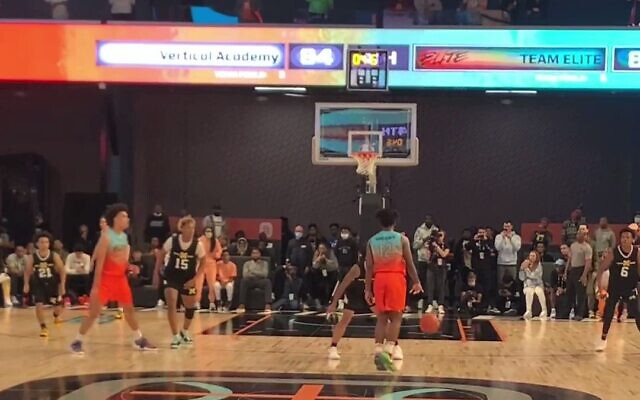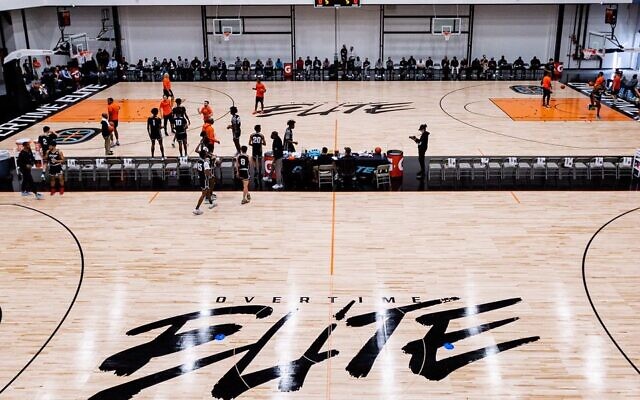Overtime Elite Complex Attracting Fans, Scouts
The 103,000 square-foot facility plays host to some of the most recruited high school basketball players in the nation.
Unbeknownst to some hoops fans, there are many nights when the Atlanta Hawks aren’t the only local professional basketball team in action.
Just over three miles due north of State Farm Arena stands Overtime Elite, a 103,000 square-foot state-of-the-art facility, headquartered at Atlantic Station, that plays host to competition involving some of the country’s most talented teenage basketball players. The league, otherwise known as OTE, was the brainchild of Dan Porter and Zachary Weiner, who co-founded the New York-based social media company Overtime in 2016, when they were colleagues working on digital content for the William Morris Agency.
What began as a social media hub for extremely gifted high school ballplayers intent on gaining social media exposure has mushroomed into a full-fledged league (effective 2021) consisting of teams stacked with six-figure-earning players who, while forgoing their college eligibility, have serious aspirations of one day joining an NBA roster.

Ironically, the only enrollee not getting paid is the program’s marquee player—Naasir Cunningham, the highest-rated basketball prospect in the class of 2024, who joined OTE last April but declined a salary in order to maintain his college eligibility. Currently, the NBA mandates that any player entering the NBA Draft be at least 19 years old during the calendar year the draft is held and at least one NBA season removed from his high school graduation, or what would have been his graduation if he hasn”t graduated. As such, elite 16-to-18-year-old prospects may compete in OTE during the latter half of their high school years as well as during the aforementioned gap year prior to the NBA Draft.
The OTE league runs from October to March, includes coaches with NBA and college experience, and is overseen by former University of Connecticut men’s basketball coach Kevin Ollie, who now serves as head of coaching and basketball development for OTE.
With its snazzy infrastructure and vast financial resources, OTE looms as a disruptive force in the world of college basketball recruiting. For starters, the massive facility in the heart of midtown Atlanta boasts a world-class weight room and sparkling new arena-style courts. The institution also has secured tens of millions of dollars in seed funding and, more recently, the financial backing of rather prominent investors including the likes of Jeff Bezos, Drake, Trae Young, and Kevin Durant.
Meanwhile, mega-sized corporations such as Gatorade, Meta, State Farm, and Topps have forged partnerships with the upstart league. Resultantly, the teenage prodigies are now able to earn well over $100,000 each year while accessing pro-style training facilities and nutritional and fitness programs and receiving educational courses on business and social justice issues, among other topics. The coursework takes place in the morning and afternoon hours before practices and games. As OTE gains further traction, it could very well serve as a viable alternative to college hoops for more high school upperclassmen basketball players weighing their options.
As ESPN college basketball analyst Jay Bilas remarked about OTE in a Los Angeles Times profile story last May, “I wouldn’t call them any sort of existential threat to the NCAA system because they’re not going to be taking all of the players,” Bilas said. “But they’ll be taking some of the top players, and that is certainly going to impact the college game.”
Although, as Bilas and others have been quick to point out, the NCAA may be able to compete on a monetary basis with the OTE due to the NIL (name, image, and likeness) deals that collegiate players can broker.
Behind the efforts of Porter and Weiner, the latter of whom is a University of Pennsylvania grad and member of Forbes “30 Under 30” list, OTE has been able to resonate with the younger generation of sports fans by tapping into the all-important world of social media.
While the showcase court can comfortably seat 1,200 fans—there are two additional ones with lower capacity seating arrangements—the on-court product is most prominently visible through the digital prism. An arena that has been unofficially dubbed a “basketball version of the TikTok mansion” was designed with the express purpose of leveraging social media outlets to its advantage. With live streaming of games only accessible to players’ families on a closed circuit, game action is spliced into action-packed highlights disseminated on social media platforms by the cadre of full-time social media employees who operate in a room known as “The Kitchen,” adjacent to the production center.
To further appeal to a certain fan demographic, the highlights are narrated by a collection of YouTube celebs who reference pop culture perhaps even more than the game action itself.
If early returns are any indication, it appears that the strategy has worked. Over the course of its inaugural season, OTE’s online audience has grown exponentially, and, to date, Overtime has more than 65 million social media followers and produces videos that average more than two billion views each month.
But, of course, fans itching for live in-person basketball when the Hawks are out of town need look no further than the gymnasium in Atlantic Station.
- Sports
- Local
- David Ostrowsky
- Atlanta Hawks
- State Farm Arena
- Overtime Elite
- Atlantic Station
- OTE
- Dan Porter
- Zachary Weiner
- William Morris Agency
- social media hub
- Naasir Cunningham
- NBA
- Draft
- University of Connecticut
- Kevin Ollie
- Jeff Bezos
- Drake
- Trae Young
- Kevin Durant
- Gatorade
- Meta
- State Farm
- Topps
- Jay Bilas
- ESPN
- NCAA
- NIL
- 30 under 30
- University of Pennsylvania
- TikTok mansion




comments